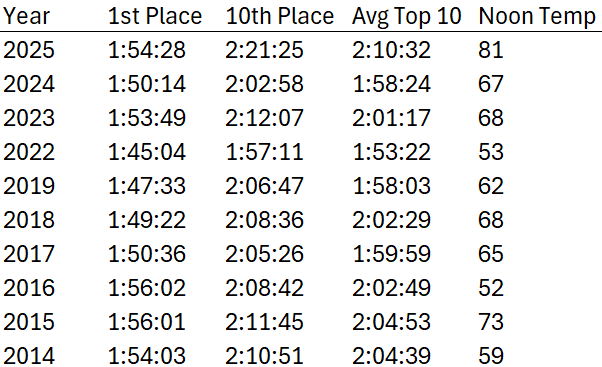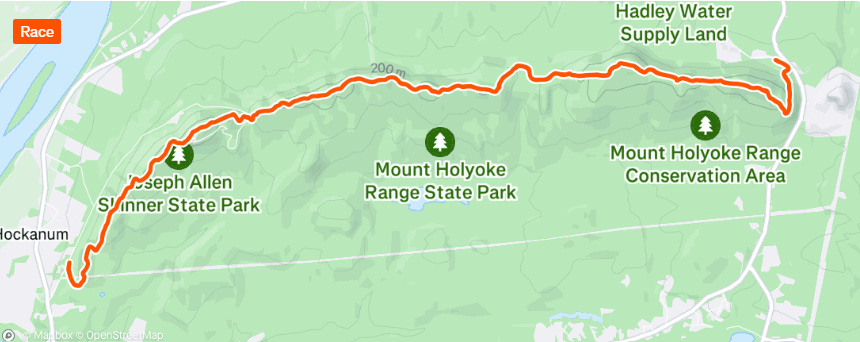Well, my initial goals were comically unrealistic given my fitness and the day (hot and humid). First I want to talk a little bit about the context of this year’s Seven Sisters in the last ten runnings of this event. Then I’ll give some details about my day on the trails.
2025 in context…spoiler alert, it was a tough one, folks.
Temperature likely had a lot to do with this year’s results (and every year). Above you can see annual noontime temperature (Weather Underground, Amherst, MA) alongside the finishing times for 1st and 10th places, as well as the average finish time for the top 10 overall (click here for the full dataset). To interegate my hypothesis that higher temps would drive down finish times (nothing Earth-shattering), I plotted out the average top 10 time against temperature. A simple linear regression showed a statistically significant relationship, albeit somewhat weak (R² = 0.421, p = 0.042). That is, temperature explains some of the variation in finish time, but far from all.
There were likely some confounding variables in the 2014 and 2016 races, which saw hisorically low tempertures, but slower than expected finishing times. Of course temperature isn’t the only predictor here. I suspect that the depth of the starting field on any given year also plays a large role. When you remove the two outliers, the relationship between finishing time and temperature becomes much clearer (R² = 0.945, p < 0.001).
There are plenty of other climatic variables that may dictate a race: the temperature leading up to race day, precipitation, humidity, etc. Regardless, noontime temp seems to be generally predictive.
Comparing 2025 to past years, it is easy to see that we all faced some challenges. First, the winning time (Dan Grip, 1:54:28) was the 3rd slowest in the past ten runnings. This in no way diminishes Dan’s performance - to run that fast in these conditions (and at age 46) is bordering on superhuman. Dan was the favorite to win - the returning champ and a past 2nd place (1:48:58) finisher - and he showed up. This year’s field was no slouch either, with three sub-1:50 runners (Liam Cregan, Brian Rusiecki) and many returning podium and top 10 finishers. Despite all of this, times were slow.
10th place (2:21:25) was the slowest it’s been (2014-2025) by over 9 minutes. This is over 24 minutes slower than 10th place in 2022 (1:57:11). Normally, if you want to run into the top 10 overall, you have to go about 2:07 (average top 10 time, 2014-2024). This year also had the slowest average top 10 time (2:10:32) by almost 6 minutes. Compared with 2022 (1:53:22), that’s 17 minutes slower.
My race…
Needless to say, my run didn’t go according to plan - however loose and unrealistic that plan was. I finished 30th overall (out of 392 finishers) in a time of 2:34:39. I missed all of my goals by a longshot. It turned out that only Dan went sub-1:55 and no one else below 2 hours. That makes me feel a little bit better I suppose.
This was my third slowest time out of the four years I’ve run. This tracks with the delta between my time and 1st place historically. However, in comparison with this year’s 10th place time, it was my 2nd closest race to cracking that barrier. I.e., if I had run 8.56% faster, I could have been 10th. What this says to me is that Dan had a really good day considering the conditions, and that the rest of the top 10 field struggled relatively speaking. Despite these comparatively slower times, all of these runners ran impressive races. Looking at the above numbers, at least I can say that I ran faster at 36 than my 27 year old self in 30 degree cooler weather! A silver lining I suppose.
Revisiting this graph of my erratic training the twelve weeks into the race, my fitness was certainly an issue. This has been my least consistent training since mid-2019. Surprisingly, my average weekly volume in 2025 is not so different from that of my fastest year at Sisters (2016), where I ran an average of 5.3 hours and 28.4 miles per week. This is compared with 4.6 hours and 28.9 miles per week in 2025. The difference in results could have to do with my lack of longer runs. In the past three months I ran a total of six times past the 2-hour mark - missing 50% of my planned long runs. It’s hard to say which and how many factors affected my performance, but these are my excuses.
As for my race narrative - I started off too hot and PR’d my way up the climb to Bare Mountain - mistake #1. My heart rate (I was wearing a Polar H10) blasted up into the 180’s and I couldn’t get it down until after the turn around - and then only slightly. After the climb it didn’t feel like I was running at an effort that warrented such a high bpm (based on experience during workouts) - anxiety and heat surely played a role - my HR always gets jacked up at the start of every race. Regardless, I should have taken some breathes and dialed it back a notch on the climbs. I will also say that Seven Sisters is not a great race for those who don’t like people breathing down their neck most of the time - the yo-yoing back and forth can be super mentally draining. Mental fatigue is real and plays into physical performance.

At 2 miles I felt cooked in more ways than one. When I left the half-way turn around (1:06:38) in 12th place, doubts had already set in and motivation was waning. I jogged some of the bottom of the main climb back up to the Mountain House, but quickly settled into walking all of the remaining hills. Somewhere around 10k I started getting calf cramps. These used to be a perennial problem of mine in racing but have thankfully not been an issue in years. This was when I knew I needed more hydration than the 2-500mL bottles of 1.5x strength Skratch I was carrying. I stopped at the Notch Rd. aid station and filled up one flask with water, popping a salt pill to boot. I believe my cramping was more related to output rather than hydration and sodium - but I knew I needed it based on my sweat rate - I’ve been tested at 1330mg/L and am a relatively high-volume sweater. I left this aid station in 18th and people kept on passing.
At this point I was hiking everything but the flats and gentler downs - anyone who has been on this trail knows these are few and far between. I stopped again at the water station before the climb up the hill with the drummer (~ mile 9) - 500mL of more water and another salt pill. From there it was an absolute trudge to the finish. I grabbed my finisher mug, skulked back to the car, and headed home to get horizontal.
Looking back at my nutrition/hydration I might have made some adjustments. I took 1-SiS Beta Fuel gel 15 minutes before start (40g carbs). At 45 min I took a Precision gel (30g), and at 1:15 I took another, this time with 100mg caffeine. In addition to this, I finished my 1L of 1.5x strength Skratch (60g) by about an hour and a half - so these were my last bit of calories. This comes out to be about 62g carbs/hr, 780mL/hr, and 820mg sodium per liter. In retrospect I should have downed my extra gel I was carrying at around 1:45 and doubled up on the salt pills with the plain water. This wouldn’t have saved my day, but I bet it would have been worth a couple extra places ahead in the results.
This mopey post is in no way meant to disuade anyone from running Seven Sisters. It’s a great event put on by a great community. I just had a hard day - which is a necessary and humbling experience from time to time. I might have not been able to run fast in the 2025 Seven Sisters Trail Race, but at least I made some fancy graphs.










Cool read. The fact that there are more than the usual number of variables influencing performance at this race versus most is what makes it so interesting to me. Temperature was a big factor, and the lack of wind exacerbated that to an extreme. Good job getting it done!